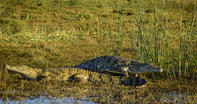
Appearance
The Nile crocodile ranges throughout Africa and shows considerable variations throughout its range. Crocodile populations can even be found in the Sahara desert. Generally, the Nile crocodile is large and can reach up to 5 m in length, with those in cooler climates only growing up to 4 m. Most juvenile Nile crocodiles in South Africa are a dark olive brown with black banding across the body and tail. This banding fades during adulthood.Crocodile Diet
Juvenile crocodiles are restricted to feeding off smaller invertebrates, but as they get older their diets consist of much larger prey. In South Africa, adult crocodiles feed on antelope, fish, large cats, buffalo and even hippos. Crocodiles are also notoriously known to eat humans.
Crocodiles are also scavengers and will walk metres from the water to feed off dead carcasses. Crocodiles have been observed to use cooperative feeding behaviour, whereby a number feed together each holding onto the carcass whilst twisting around using their tails to tear off chunks of meat. Other cooperative behaviours noted are where the animals seal off an area of water to concentrate the fish making them easier to catch.
In these instances, there is a defined feeding hierarchy witnessed, with the dominant croc feeding first. Many believed that the crocodile leaves its kill in the water as it prefers its kill decomposed, however, this is not true. The crocodile does not wait for the flesh to rot before feeding but will allow it to become perhaps softer in the water.
Crocodile Breeding
The breeding season for the crocodile varies with geographical location. Usually, in the north, it is during the dry season and the start of the wet season further south. Females dig holes away from the water’s edge to make a 50 cm deep nest where they lay between 40-60 eggs.
Females and males reach sexual maturity based on their size. Incubation lasts 80-90 days with the female remaining in close proximity to the nest throughout this period. Once hatched, the female will carry the young to water.
Crocodile creches are formed with other females who tend the hatchlings and juveniles for up to two years after hatching. As the female crocodile must regularly abandon the nest to cool off in the water, the nests are constantly under threat from predators, especially monitor lizards, hyenas and humans.
Crocodile Behaviour
Not much is understood about the crocodile’s behaviour. It is believed that a strong social hierarchy exists within the crocodile populations that affect their feeding.Where they are found
Various crocodile species are found throughout the continent of Africa. In South Africa, they mainly occur in the North Eastern regions and provinces.Latin Name
Crocodylus niloticus. Crocodiles are widely distributed throughout Africa and several possible subspecies proposed due to the population differences that have been observed. The differences are rarely noted in the literature, however, and they are not officially recognised.
C. n. africanus (East African Nile Crocodile), C. n. chamses (West African Nile crocodile), C. n. corviei (South African Nile crocodile), C. n. madagascariensis (Malagasy Nile crocodile, Malagasy alligator, Croco Mada), C. n. niloticus (Ethiopian Nile crocodile), C. n. pauciscutatus (Kenyan Nile crocodile, Kenya alligator, Kenya caiman), C. n. suchus (Central African Nile crocodile).